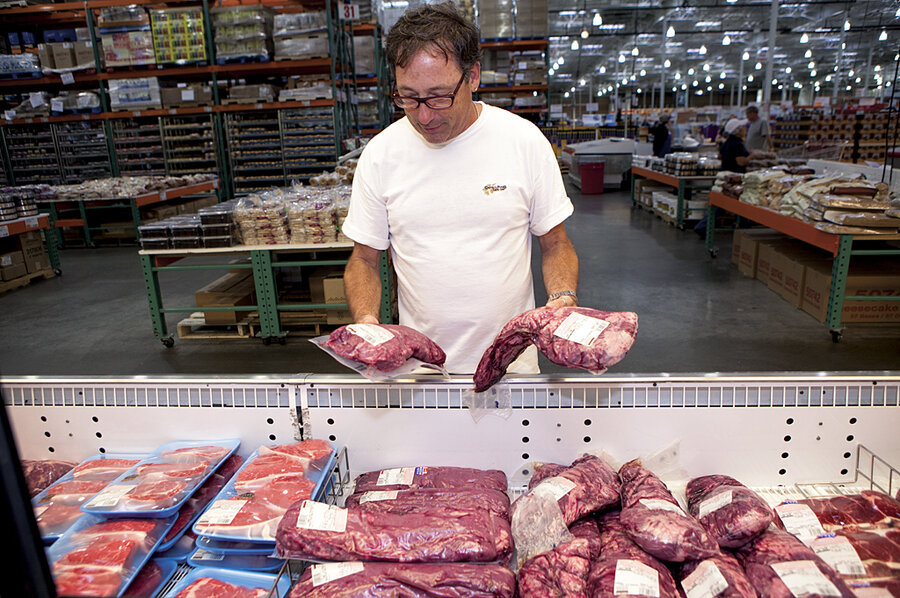Attention, shoppers! Food prices are rising.
| New York
Even if you never set foot in a supermarket, track commodity prices, or buy wheat futures, you probably have noticed this trend: Food prices are going up.
Nan Braun knows. Since Thanksgiving, "I've been paying at least another $50 a month more for food for the family," says the Kokomo, Ind., resident. She's responded by purchasing some foods in bulk when they're on sale – and buying flour for making bread.
Susan Unger-Grossman of New York City has noticed a change. The price of the box of single-serving coffee packets she often buys hasn't changed, but the number of packets per box has dropped from 24 to 18. "That means if you'd buy three boxes of the coffee, you'd be losing the equivalent of a whole box," she points out.
These changes are early hints of a much broader increase in food prices that should come later this year. The rise in commodity food and energy prices will boost costs at the grocery store this year anywhere from 2 to 4 percent – or possibly even higher, analysts forecast. That's not unprecedented. A rise of 2 to 3 percent in consumer food prices would mark a return "toward the historical average" food inflation rate, according to the US Department of Agriculture. It just feels huge because last year, consumers' price of food inched up only 0.8 percent – the lowest food inflation rate since 1962, according to the USDA.
Some foods will go up in price more than others. Shoppers can expect a rise of 2.5 to 3.5 percent for beef and 4.5 to 5.5 percent for dairy products, the USDA forecasts. But nonalcoholic beverages will post price increases of only 1 to 2 percent.
Commodity food prices are rising now because improving diets are fueling world demand for food even as agricultural supplies are tightening. Cattle herds have thinned, and weather problems, including floods, droughts, and wildfires, have hurt crop output in such key crop-growing areas as Russia and Australia. The result, experts say, is a surge in raw materials prices.
For example: Wheat prices leapt 47 percent last year on the futures market. In January, cattle futures hit a record high. Even as world demand rises, "supplies of raw materials for food are even tighter this year than in 2008" – when most agricultural commodity prices hit all-time highs, says Terry Roggensack, a partner at The Hightower Report, a Chicago-based forecaster of commodity and financial futures. He expects most commodity food prices – except for wheat – to hit record highs this year.
In turn, rises in energy prices boost the cost of food production and transportation.
For consumers, the brunt of the price increases – at least those stemming from higher food commodity prices – will surface a bit later in the year, says Matt Arnold, consumer analyst at St. Louis-based Edward Jones. "Companies will want to acclimate consumers to [pricing] changes."
Amid high joblessness and other problems, food retailers "have been hesitant to pass on to the consumer higher" wholesale costs of food, says Brian Todd, chief executive officer of The Food Institute, an information service for the food industry based in Upper Saddle River, N.J. Through December, "wholesale price increases have outpaced price increases at the retail level for the last 15 months – the longest period that has ever happened" since the institute began tracking that trend about five years ago.
Instead of hiking prices, some companies will trim food package sizes or curb price promotions, experts predict. Even if "the price of a box of something hasn't changed, consumers" won't be "able to buy it as much on discount," says Michael Swanson, an agricultural economist in Bloomington, Minn., with Wells Fargo Bank. Effectively, this still makes it "more expensive to eat, even though the price hasn't changed."
Of course, consumers can find ways to resist higher prices. Budget-conscious shoppers can switch to lower-priced stores or buy less costly products, such as, say, chicken instead of beef. If they have the space and desire, they can even grow some of their own food.
They can also dine out less often, which might be a good idea for the budget-conscious since restaurants, too, are hiking costs. "Food away from home" should cost consumers 2 to 3 percent more this year, according to the USDA.
McDonald's Corp. has already tipped its hand. In a Jan. 24 conference call with analysts, Peter Bensen, chief financial officer, said: "As commodity and other cost pressures become more pronounced as we move throughout the year, we will likely increase prices to offset some, but not necessarily all, of these cost increases."





